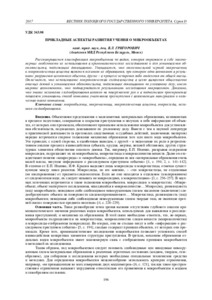Пожалуйста, используйте этот идентификатор, чтобы цитировать или ссылаться на этот ресурс:
https://elib.psu.by/handle/123456789/20769| Название: | Прикладные аспекты развития учения о микрообъектах |
| Авторы: | Григорович, В. Л. |
| Дата публикации: | 2017 |
| Издатель: | Полоцкий государственный университет |
| Библиографическое описание: | Вестник Полоцкого государственного университета. Серия D, Экономические и юридические науки. - 2017. - № 6. – С. 196-200. |
| Аннотация: | Рассматривается классификация микрообъектов по видам, которая отражает в себе закономерные особенности их использования в криминалистических исследованиях и для установления обстоятельств, подлежащих доказыванию. Указывается, что отличительной чертой микрочастиц и микроколичества веществ является механизм их образования, при котором одни возникают в результате разрушения целостного объекта, другие – в процессе испарения либо отделения от общей массы. Отмечается, что использование микроколичества следов-веществ в целях выявления общественно опасных деяний и установления обстоятельств, подлежащих доказыванию по уголовному делу, имеет широкие возможности, что подтверждается результатами исследования микроволокон. Доказано, что знание механизма следообразования волокон на поверхностях рук и в подногтевом пространстве позволяет установить способ контакта участников преступления с волокнистым материалом и количество таких контактов.= Classification of microobjects by types which reflects in itself natural features of their use in criminalistic researches and for establishment of the circumstances which are subject to proof is considered. It is specified that distinctive feature of microparticles and microamounts of substances is the mechanism of their education at which one result from destruction of a complete object, others – in the course of evaporation or separation from lump. It is noted that use of microquantity of traces substances for identification socially dangerous act and establishment of the circumstances which are subject to proof on criminal case has ample opportunities that is confirmed by results of a research of microfibres. It is proved that knowledge of the mechanism of a trace formation of fibers on the surfaces of hands and in subnail space allows to establish a way of contact of participants of a crime with fibrous material and the number of such contacts. |
| Ключевые слова: | Государственный рубрикатор НТИ - ВИНИТИ::ОБЩЕСТВЕННЫЕ НАУКИ::Государство и право. Юридические науки Микрообъекты Микрочастицы Микроколичества веществ Микроследы Механизм следообразования Microobjects, microparticles Microamounts of substances Microtraces Mechanism of trace formation |
| URI (Унифицированный идентификатор ресурса): | https://elib.psu.by/handle/123456789/20769 |
| Права доступа: | open access |
| Располагается в коллекциях: | 2017, № 6 |
Файлы этого ресурса:
| Файл | Описание | Размер | Формат | |
|---|---|---|---|---|
| 196-200.pdf | 155.84 kB | Adobe PDF |  Просмотреть/Открыть |
Все ресурсы в архиве электронных ресурсов защищены авторским правом, все права сохранены.